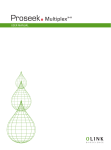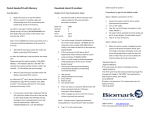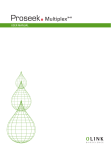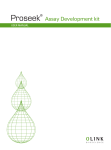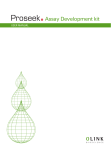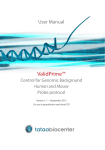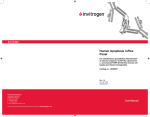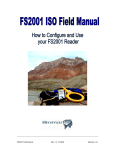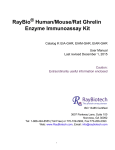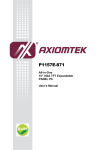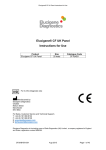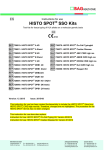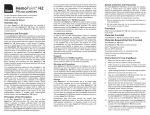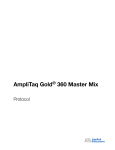Download Proseek Multiplex User Manual
Transcript
Multiplex 96×96 USER MANUAL TECHNICAL SUPPORT For technical support, please contact us at [email protected] or +46 18 444 3970 Table of content 1. INTRODUCTION 4 2. PRINCIPLE OF THE ASSAY 2.1 Technology and assay format 5 5 3. REAGENTS AND EQUIPMENT 3.1 Reagents supplied 3.2 Required consumables (not supplied) 3.3 Required equipment (not supplied) 3.4 Software for analysis 3.5 Downloads 3.6 Technical controls 6 6 7 7 8 8 8 4. ASSAY CONSIDERATIONS 4.1 Safety 4.2 PCR Technology 4.3 Pipetting techniques 4.4 Sample preparation 4.5 Sample material 9 9 9 9 9 9 5. ASSAY PROTOCOL 5.1 Experimental design 5.2 Plate layout 5.3 PEA Program 5.4 Olink Protein Expression 96×96 program 5.5 Fluidigm instructions 5.6 Proseek Multiplex96×96 protocol 10 10 10 11 11 11 12 6. RESULTS AND DATA ANALYSIS 6.1 Export the data 6.2 Data units 6.3 Olink Wizard for GenEx Software 16 16 16 16 7. REFERENCES 16 APPENDIX 1 17 APPENDIX 2 Tissue Lysates Lysis buffer 1 Lysis buffer 2 19 19 19 19 Proseek Multiplex96×96 3 1. Introduction Proseek® Multiplex96×96 from Olink Bioscience provides high-multiplex immunoassays, enabling simultaneous measurement of 92 protein biomarkers in 1 µL sample volume. The Proseek platform is designed for ease of use and offers enhanced analytical performance, analysis of complex matrices, as well as improvement in assay throughput over conventional immunoassays. To get you started, Proseek Multiplex96×96 reagents come as a convenient all-in-one kit format with an optimized protocol. 4 Proseek Multiplex96×96 2. Principle of the assay 2.1 TECHNOLOGY AND ASSAY FORMAT The Proseek reagents are based on PEA, a Proximity Extension Assay technology1, in which 96 oligonucleotide-labeled antibody pairs are allowed to bind to their respective protein targets in the sample. A PCR reporter sequence is formed by a proximity-dependent DNA polymerization event and is subsequently detected and quantified using real-time PCR. The assay is performed in a homogeneous 96-well format with no need for washing steps. Proseek Multiplex assay procedure employs three core steps: INCUBATION EXTENSION Allow the 96 antibody probe pairs to bind to their respective proteins in your samples. Create and pre-amplify 96 unique DNA reporter sequences by proximity extension. DETECTION Quantify each biomarker’s DNA reporter using high throughput real-time PCR instrument. Fig 1. Assay procedure. Proseek Multiplex96×96 5 3. Reagents and equipment 3.1 REAGENTS SUPPLIED Each Proseek Multiplex 96×96 kit contains reagents for 96 wells, sufficient for 90 samples and 6 controls. The reagents are supplied in three individual boxes. Storage temperature and expiry date for the components are stated on the outer label of each box. 3.1.1 PROSEEK MULTIPLEX PROBE KIT 96×96 (STORE AT +4°C) Incubation Solution Contains components needed for the incubation reaction A-probes Contains 96 antibody probes labeled with A oligos B-probes Contains 96 antibody probes labeled with B oligos 3.1.2 PROSEEK MULTIPLEX DETECTION KIT 96×96 (STORE AT -20°C) PEA Solution Contains components needed for the extension reaction PEA Enzyme For extension of A and B probes which are bound to their target PCR Polymerase For pre-amplification of the extension product created by the PEA enzyme Detection Solution Contains components needed for the detection reaction Detection Enzyme For qPCR amplification Primer Plate 96-well plate with ready-to-use primers for amplification of extension product 3.1.3 PROSEEK MULTIPLEX CONTROLS (STORE AT -20°C) 6 Interplate Control For normalization between runs Negative Control For determination of background levels Incubation Stabilizer For stabilization of the incubation reaction Proseek Multiplex96×96 3.2 REQUIRED CONSUMABLES (NOT SUPPLIED) Pipette filter tips Microcentrifuge tubes (1-1.5 mL) Centrifuge tube (> 11 mL) 8-well strips with lids 96-well PCR plate (à 0.2 mL) Multi-channel pipette reservoir Adhesive plastic film (heat-resistant) High purity water (sterile filtered, MilliQ® or similar) 96.96 Dynamic Array™ Integrated Fluidic Circuit (IFC), (Fluidigm Corporation, catalogue number BMK-M96.96) 3.3 REQUIRED EQUIPMENT (NOT SUPPLIED) Pipettes (covering the range from 1 μL to 1000 μL) Multi-channel pipettes (recommended range 1-10 µL and 50-100 µL and/or 50-200 µL) Vortex Centrifuge for plates Microcentrifuge for tubes Freezing block (-20°C) for enzyme handling Thermal cycler with: Heated lid Temperature range from 50°C to 95°C Validated for 0.1mL volumes - important 96-well format (recommended) (Olink has tested ABI 2720 and ABI Veriti® 96-Well Thermal Cycler) Refrigerator or cold room (+2°C to +8°C) Fluidigm BioMark™ or BioMark™ HD System Fluidigm IFC controller HX Proseek Multiplex96×96 7 3.4 SOFTWARE FOR ANALYSIS Each Proseek Multiplex 96×96 experiment will generate 9216 data points. It is advisable to use a multivariate statistical software for data analysis. We recommend the GenEx software developed by MultiD Analyses AB. GenEx offers an easy-to-use Olink Wizard to guide you through the different steps of data preprocessing followed by a wide variety of statistical analysis such as hierarchical clustering methods, principal components analysis, ANOVA tests and more. For more information please contact [email protected]. 3.5 DOWNLOADS The list of proteins can directly be imported into the Fluidigm Analysis software as a .plt file. Download the Detector Setup.plt file corresponding to your panel at www.olink.com/products/proseek-multiplex/downloads/data-analysis-files. For data normalization without the Olink Wizard for GenEx, please download the DataPreprocessing.xlsx file at http://www.olink.com/products/proseek-multiplex/data-analysis. 3.6 TECHNICAL CONTROLS Each Proseek Multiplex 96x96 kit contains Incubation, Extension and Detection Controls. The internal controls are included in the assay reagents, and hence added to each sample to be tested. Any technical variation in the three steps of the assay (Incubation, Extension and Detection) is monitored by the Incubation Control. This control measures spiked nonhuman antigens. The Extension control is used for nomalization and compensates for any variation between samples in the Extension and Detection steps of the assay. It is an antibody proximity-independent control and is not, therefore, affected during incubation. To monitor the Detection step, a synthetic olignucleotide is used. The Detection Control is not, therefore, affected during Incubation or Extension. 8 The three replicates of Interplate Control are used for normalization and compensates for possible variation between runs. The three replicates of Negative Control are used to calculate the lower limit of detection (LOD) for each protein. Proseek Multiplex96×96 4. Assay considerations 4.1 SAFETY Follow general laboratory safety procedure such as using gloves, safety goggles and protective clothing when performing the experiments. Handle and dispose of hazardous sample material according to local regulations. 4.2 PCR TECHNOLOGY PCR technology is sensitive to contaminations; perform the Detection step in a post-PCR room, separate from the room where the Incubation and Extension steps (to step 19, page 13) are performed. Maintain and calibrate your PCR and BioMark instruments regularly. 4.3 PIPETTING TECHNIQUES It is advisable to use a multi-channel pipette and a reverse pipetting technique in the reagent transfer steps. Maintain and calibrate your pipettes regularly. 4.4 SAMPLE PREPARATION To reduce sample-handling time during the experiment, samples can be aliquoted in 8-well strips or 96-well plate prior to the start of the experiment. 4.5 SAMPLE MATERIAL Proseek Multiplex96×96 has been validated on EDTA plasma and serum samples. A range of additional sample types are compatible with the technology; such as citrate plasma, heparin plasma, tissue and cell lysates and saliva. Different sample matrices are expected to affect the detection of specific proteins. In addition, extreme levels of blood plasma/serum IgG (e.g. multiple myeloma) may interfere with the Proseek assay. For more information on sample material, please see the Data Validation documents corresponding to each panel. Guidelines on tissue lysate buffers are available in Appendix 2. For questions, please contact support@ olink.com. Proseek Multiplex96×96 9 5. Assay protocol 5.1 EXPERIMENTAL DESIGN It is important to plan your experimental design properly to get the data you need to answer your questions. Decide how many samples, replicates and controls you will need to get the data you want. Make sure your samples are randomized appropriately when running more than one plate. Consult a statistician to be on the safe side prior to running your study. 5.2 PLATE LAYOUT Prior to running the Proseek Multiplex96×96 assay, plan the distribution of samples across the plate. Make sure the samples are distributed randomly. It is important to place the Negative Control and the Interplate Control in the last 6 wells according to Figure 2. Proseek Multiplex 96×96 kit is designed for 90 samples, three replicates of Negative Control and three replicates of Interplate Control. For analysis of less than 90 samples, please pipette replicates of selected samples. If running a Proseek Multiplex assay that requires pre-diluted samples, read the instructions provided in Sample Dilution Guidelines. 1 2 3 4 5 6 7 8 9 10 11 A B C D E F G H Negative Control Fig 2. Plate layout. 10 Proseek Multiplex96×96 Interplate Control Samples 12 5.3 PEA PROGRAM Create a PEA program on the thermal cycler with the following conditions. Enable the heated lid function. Extension 50°C 20 min Hot start 95°C 5 min PCR Cycle 95°C 30 s 54°C 1 min 60°C 1 min 10°C ∞, hold Maintain the reaction at ×17 5.4 OLINK PROTEIN EXPRESSION 96×96 PROGRAM Program the Fluidigm BioMark System with the following steps. Name the program Olink Protein Expression 96×96 program. 50°C 120 s 70°C 1800 s 25°C 600 s Hot Start 95°C 300 s PCR Cycle 95°C 15 s 60°C 60 s Thermal mix ×40 Verify correct settings: Application – Gene Expression Passive Reference – 5-Carboxy-x-Rhodamine (abbreviation ROX in Fluidigm software) Assay – single probe Probes – FAM-MGB 5.5 FLUIDIGM INSTRUCTIONS For information on the Fluidigm IFC Controller HX and Fluidigm BioMark System, please read through the following User Guides (www.fluidigm.com) Fluidigm® IFC Controller User Guide - PN 68000112 Fluidigm® Real-Time PCR Analysis User Guide - PN 68000088 Fluidigm® Data Collection Software User Guide - PN 68000127 Proseek Multiplex96×96 11 5.6 PROSEEK MULTIPLEX96×96 PROTOCOL Before starting: Please read the entire Proseek Multiplex96×96 protocol. Use the 96-well plate template in Figure 2 and select a location for each sample. Dilute your samples if running a Proseek assay that requires pre-dilution. Day 1: INCUBATION 1. Thaw samples, vortex and spin down the content at 150 × g, 1 min at room temperature. 2. Thaw the Incubation Stabilizer from the Proseek Multiplex Controls box, vortex and spin briefly. 3. Thaw the Interplate Control and Negative Control from the Proseek Multiplex Controls box, vortex and spin briefly. 4. Prepare the following Incubation mix in a microcentrifuge tube. Vortex and spin each reagent before transfer to the mix. Incubation mix per 96-well plate (µL) Incubation Solution 280.0 Incubation Stabilizer 40.0 A-probes 40.0 B-probes Total 40.0 400.0 5. Vortex the Incubation mix briefly and spin down the content. Transfer 47 µL per well of the Incubation mix by using reverse pipetting to an 8-well strip. 6. Use a multi-channel pipette to transfer 3 µL of the Incubation mix from the 8-well strip to the bottom of each well of a 96-well plate by using reverse pipetting. Do not change pipette tips. Name this plate Incubation Plate. 7. Add 1 µL of each sample to the bottom of the well of the Incubation Plate according to your plate layout. 8. Add 1 µL of Negative Control to the bottom of each well in position C12, D12 and E12 according to the plate layout in Figure 2. 9. Add 1 µL of Interplate Control to the bottom of each well in position F12, G12 and H12. 10. Seal the Incubation Plate with an adhesive plastic film. It is important that all wells are properly sealed, especially around the edges to avoid evaporation of samples. Spin down the content at 150 × g, 1 min at room temperature. 11. Incubate the Incubation Plate overnight at +2°C to +8°C. 12 Proseek Multiplex96×96 Note: Pipette the Incubation Solution carefully to avoid foaming. Please note that the volumes have been changed from previous version (v.1.3). Note: Pipette from the uppermost part of the Incubation mix to prevent liquid from sticking to the outside of the pipette tip. Note: Add the controls to a 8-well strip and use a multi-channel pipette for steps 7-9. Day 2: EXTENSION 12. Turn on your thermal cycler and activate the heated lid function. 13. Thaw the PEA Solution, vortex and spin briefly. Prepare the following Extension mix in a centrifuge tube. Use a freezing block when removing the PEA Enzyme and the PCR Polymerase from -20°C and spin down the content briefly before pipetting the enzymes into the mix. Extension mix per 96-well plate (µL) High Purity Water 9385 PEA Solution 1100 PEA Enzyme 55 PCR Polymerase Total 22 10 562 14. Vortex the Extension mix. 15. Bring the Incubation Plate to room temperature. Spin down the content at 150 × g, 1 min at room temperature. 16. Pour the Extension mix into a multi-channel pipette reservoir. 17. Carefully remove the plastic adhesive film from the Incubation Plate. 18. Start a timer set for 5 min and transfer 96 µL of Extension mix to each well of the Incubation Plate by using reverse pipetting. Do not change pipette tips, place the tips against the upper parts of the well wall. Make sure the tips never come in contact with the contents of the wells. 19. Add a new plastic adhesive film to the Incubation Plate. It is important that all wells are properly sealed, especially around the edges to avoid evaporation of samples. Note: Perform steps 18–20 within 5 minutes. 5 min 20. Vortex gently and spin down the content at 150 × g, 1 min at room temperature. Preheat the PCR machine. 21. After the 5 min, place the Incubation Plate in the thermal cycler and run the PEA program (see section 5.3 for details). The PEA program takes approximately 1 h 40 min. Note: If your thermal cycler requires a silicon cover for plates covered with plastic film, please use one to avoid evaporation. 22. Continue with the Detection step or store the Incubation Plate for up to one week at +4°C. Proseek Multiplex96×96 13 DETECTION 23. Prepare and prime a 96.96 Dynamic Array IFC according to the manufacturer’s instructions. 24. Thaw the Primer Plate, vortex and spin at 150 × g, 1 min at room temperature. 25. Thaw the Detection Solution, vortex and spin briefly. Prepare the following Detection mix in a microcentrifuge tube. Use a freezing block for the Detection Enzyme and PCR Polymerase and spin down the content briefly before pipetting the enzymes into the mix. Detection mix per 96-well plate (µL) Detection Solution 550.0 High Purity Water 230.0 Detection Enzyme 7.8 PCR Polymerase 3.1 Total 790.9 26. Vortex the Detection mix and spin briefly. Transfer 95 µL of the Detection mix per well to an 8-well strip. 27. Use a multi-channel pipette to transfer 7.2 µL of Detection mix to each well of a new 96-well plate by reverse pipetting. Name this plate Sample Plate. 28. Remove the Incubation Plate from the thermal cycler, vortex and spin down the contents. 29. Carefully remove the plastic film and transfer 2.8 µL from each well of the Incubation Plate to the Sample Plate. 30. Seal the Sample Plate with a new plastic adhesive film, vortex and spin at 150 × g, 1 min at room temperature. 14 Proseek Multiplex96×96 Note: For steps 31 and 32, make sure not to leave any inlets empty on the chip. 31. Gently remove the Primer Plate sealing to avoid contamination between wells. Transfer 5 µL from each well of the Primer Plate to the primed 96.96 Dynamic Array IFC by using reverse pipetting. Change pipette tips after each primer. Primers are loaded into their respective inlets on the left side of the chip according to Figure 3. 1 2 3 4 5 6 7 8 9 10 11 12 1 A A B B C C D D E 2 3 4 5 6 7 8 9 10 11 12 E F F G G H H Primer Plate Sample Plate Primers Samples Fig 3. Loading of primers and samples to the 96.96 Dynamic Array IFC. 32. Transfer 5 µL from each well of the Sample Plate into the inlets on the right side of the chip according to Figure 3 by reverse pipetting. Change pipette tips after each sample. See Appendix 1 for a detailed instruction on sample loading. Note: The chip should be oriented so that the cut corner of the chip is placed on your upper left side. 33. Remove any visible bubbles, e.g. with a pipette tip or syringe needle and change between each well. 34. Load the chip in the Fluidigm IFC Controller HX according to manufacturer’s instructions. 35. Run the Olink Protein Expression 96×96 Program in the Fluidigm Biomark Reader according to manufacturer’s instructions (See 5.4 for detailed instructions on the Olink Protein Expression 96×96 Program). Proseek Multiplex96×96 15 6. Results and data analysis 6.1 EXPORT THE DATA Verify the BioMark run using the Fluidigm Real-Time PCR analysis software according to manufacturer’s instructions. Export your data to a spreadsheet (see Olink Wizard for GenEx User Guide for a detailed instruction). 6.2 DATA UNITS The Proseek assay generates Cq values. To even out variation between runs and within run, the data should be normalized using the Extension Control, Interplate Control and a correction factor. The data used for further statistical analysis is in Normalized Protein Expression (NPX) units on log2 scale where a high value corresponds to high protein concentration. For calculating Coefficient of Variation (%CV) between replicate samples, you need to use linear values. Convert your NPX values to linear values by using this formula: 2^(NPX). For normalization of your data, please use the Olink Wizard for GenEx or download the DataPreprocessing.xlsx file corresponding to your panel at www.olink.com. 6.3 OLINK WIZARD FOR GENEX SOFTWARE Each Proseek Multiplex96×96 experiment will generate 9216 data points. To facilitate data analysis we recommend the Olink Wizard plugin for GenEx. GenEx is a multivariate statistical analysis software developed by MultiD Analyses AB (www.multid.se). The Olink Wizard for GenEx, will guide you through data qualification steps and provide you with Normalized Protein Expression (NPX) values for further statistical analysis. The GenEx software offers a variety of statistical analysis tools such as hierarchical clustering methods, principal components analysis, ANOVA tests and more. Different visualization tools, including scatter plot, box and whisker plot or bar graph, allow you to rapidly identify major differences across samples and provide you with images for data presentations. For further information about data analysis, please contact Olink at [email protected]. 7. References 1. Lundberg, M., et.al. Homogeneous antibody-based proximity extension assays provide sensitive and specific detection of low abundant proteins in human blood. Nucleic Acid Res 6 June (2011). doi: 10.1093/nar/gkr424. 2. Assarsson E., et.al. Homogenous 96-Plex PEA Immunoassay Exhibiting High Sensitivity, Specificity, and Excellent Scalability. PLOS One 6 April (2014) 9:4. e95192. 16 Proseek Multiplex96×96 Appendix 1 Load primers to the left and samples to the right on the 96.96 Dynamic Array IFC. 1 2 3 4 5 6 7 8 9 10 11 12 1 A A B B C C D D E E F F G G H H 2 3 4 Primer Plate 5 6 7 8 9 10 11 12 Sample Plate Primers Samples Proseek Multiplex96×96 17 1. Transfer 5 µL by using reverse pipetting from each well in the Primer Plate to the inlets on the left side of the chip in the same manner as described in steps 2-4 for Sample Plate. 1 2 3 4 5 6 7 8 9 10 11 12 A B C D E F G H Primer Plate Samples Primers 2. Use reverse pipetting. Transfer 5 µL from each well in position 1 A-H (marked in green) to inlets in the first column on the right side of the chip (green). When using an eight-channel pipette every other inlet will be filled according to the image. 1 2 3 4 5 6 7 8 9 10 11 12 A B C D E F G H Sample Plate Primers Samples 3. Transfer 5 µL from each well in position 2 A-H (blue) to the second column of inlets (blue) according to image. Continue with columns 3-6. 1 2 3 4 5 6 7 8 9 10 11 12 A B C D E F G H Sample Plate Primers Samples 4. Transfer 5 µL from each well in position 7 A-H (red) to inlets in the first column on the right side of the chip (red), start on the second row according to image. Continue with columns 8-12. 1 2 3 4 5 6 7 8 9 10 11 12 A B C D E F G H Sample Plate Primers 18 Proseek Multiplex96×96 Samples Appendix 2 TISSUE LYSATES Proseek Multiplex96×96 is compatible with human tissue lysates. Two different lysis buffers and different tissues such as lung, muscle, endometrial and skin/melanoma tissue have been tested. Optimization of lysis buffer may be necessary, depending on the tissue type. After lysis, determine the total protein concentration in each sample and standardize by diluting high level samples. Make sure you have equal amount of total protein in each sample before running the assay. Samples standardized to approximately 0.5-1 mg/mL based on protein determination carried out using BCA Protein Assay (Lowry) show good result with Proseek Multiplex 96×96. Specific tissues could have very high expression of certain proteins and further dilution may be necessary for the Proseek Multiplex assay, e.g. 1:50 or 1:100. LYSIS BUFFER 1 1x RIPA buffer: (50mM Tris-HCl pH 7.4, 150 mM NaCl, 1 mM EDTA, 1 % Triton X-100, 0.1 % Sodium deoxycholate) Add fresh to 1x RIPA buffer: Serine protease inhibitor Phenylmethylsulfonyl fluoride (PMSF) to 1 mM Protease Inhibitor cocktail:(final conc 10.4 mM AEBSF, 8 µM Aprotinin, 0.2 mM Leupeptin, 0.4 mM Bestatin, 0.15 mM Pepstatin, 0.14 mM E-64) LYSIS BUFFER 2 Bio-Plex Cell lysis kit (cat number 171-304011, Bio-Rad) Add fresh to buffer: + Factors 1 and 2 (from the kit) + Protease inhibitor cocktail from Roche (cat number 11 836153001) For protein determination using BCA (Lowry) method, dilute samples 1:5 in PBS. For questions, please contact [email protected]. Proseek Multiplex96×96 19 Olink Bioscience Dag Hammarskjölds v. 52B SE-752 37 Uppsala, Sweden www.olink.com 0935, v.1.6, 2015-09-29 For Research Use Only. Not for Use in Diagnostic Procedures. This product includes a license for non-commercial use of Proseek products. Commercial users may require additional licenses. Please contact Olink AB for details. There are no warranties, expressed or implied, which extend beyond this description. Olink AB is not liable for property damage, personal injury, or economic loss caused by this product. The following trademarks are owned by Olink AB: Olink®, Olink Bioscience™, Proseek®. This product is covered by several patents and patent applications including US 6,511,809, US 7,306,904, US 5,665,539 and related US and foreign patents. This product is sold under license from PHRI Properties, Inc. and may be used under PHRI Properties patent rights outside the field of human in vitro diagnostics. Components in the Proseek Multiplex Probe Kit utilise Lightning-Link™ technology and are provided under license from Innova Biosciences. Fluidigm and BioMark are trademarks or registered trademarks of Fluidigm Corporation. All third party trademarks are the property of their respective owners. © Copyright 2014 Olink AB.




















